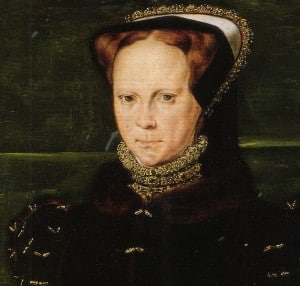 On this day in history, 17th November 1558, Henry VIII’s eldest child, Queen Mary I, died. She was just 42 years old.
On this day in history, 17th November 1558, Henry VIII’s eldest child, Queen Mary I, died. She was just 42 years old.
In his recent biography of Mary, “Mary Tudor”, David Loades writes of Mary “seems to have retreated into her shell” after her husband Philip’s second departure in July 1557. He writes of how “apart from the state opening of Parliament on 20 January 1558, and the relevant high mass, there are almost no mentions of her appearance, and the revels accounts tell a similar story” and that “Mary seems to have lacked all enthusiasm” for entertainment such as masks and plays. Obviously, Mary believed that she was pregnant in early 1558 but it does sound as if the Queen was withdrawing into herself. It may well have been that she was stressed and depressed, or perhaps her health was affecting her.
After Easter 1558, Mary I made her will. Loades points out that this was not because she was seriously ill but because she believed that she was pregnant. In fact, she started her will with the words “Thinking myself to be with child in lawful marriage…” Loades believes that this second phantom pregnancy “was all happening in Mary’s own mind” because when she made her will birth should have been imminent since Philip had departed in July 1557, yet there is no mention in the records of preparations being made such as nursery staff being appointed, remarks on her changing body shape, preparations for confinement etc. Poor Mary.
David Loades writes of how, “with the benefit of hindsight”, we can see how Mary’s health began to decline after that, although nobody seems to have been unduly worried at the time. In August 1558, Mary contracted a fever and although she was able to fight that off she was reported to be suffering from a “dropsy” at the end of September. At the end of October she made an addition to her will and although she did not name Elizabeth, her half-sister, she did confirm that the throne would go to the next lawful heir and that was Elizabeth. The Duke of Feria arrived at the English court on the 9th November and reported to his master, Mary’s husband Philip II of Spain, on the 14th November:-
“there is… no hope of her life, but on the contrary each hour I think that they will come to inform me of her death, so rapidly does her condition deteriorate from one day to the next.”
Loades writes of how, in her last days, she “confided to those about her that she had had a vision of angels ‘like little children'” and that she also spoke of how the word “Calais” would be found written across her heart after her death. She received the ‘viaticum’, the special holy communion for the dying, on the 17th November and was able to make the appropriate responses before she lapsed into unconsciousness, never to wake again. The exact time of her death is not recorded as it was not noticed, she slipped peacefully away.
It was the end of an era, as the crown of England passed from one of Henry VIII’s daughters to the other, from Mary I to Elizabeth I. Although it doesn’t seem to have been said at the time, I’ll say it now: “The Queen is dead! Long live the Queen!”
Notes and Sources
- Mary Tudor, David Loades, Chapters 11 and 12, “Mary & Elizabeth” and “Elizabeth the Heir”